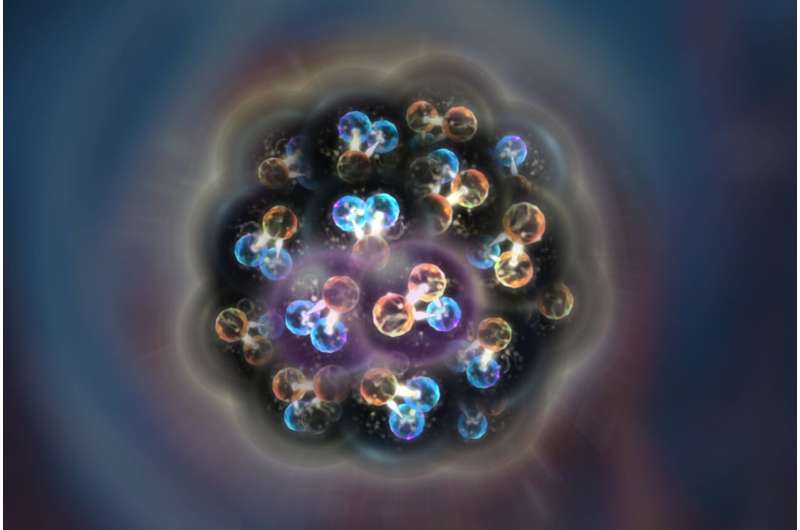The atomic nucleus is made up of protons and neutrons, particles that exist through the interaction of quarks bonded by gluons. It would seem, therefore, that it should not be difficult to reproduce all the properties of atomic nuclei hitherto observed in nuclear experiments using only quarks and gluons. However, it is only now that physicists, including those from the Institute of Nuclear Physics of the Polish Academy of Sciences in Cracow, have succeeded in doing this.
It’s been almost a century since the discovery of the main components of atomic nuclei: protons and neutrons. Initially, the new particles were considered indivisible. In the 1960s, however, there was a suggestion that, at sufficiently high energies, protons and neutrons would reveal their internal structure—the presence of quarks constantly held together by gluons.
Soon afterwards, the existence of quarks was confirmed experimentally. It may therefore seem surprising that, despite the passage of many decades, no one has been able to reproduce with quark-gluon models the results of nuclear experiments at low energies when only protons and neutrons are visible in atomic nuclei.
This long-standing deadlock has only now been broken, in a paper published in Physical Review Letters. Its main authors are scientists from the international nCTEQ collaboration on quark-gluon distributions, including those from the Institute of Nuclear Physics of the Polish Academy of Sciences (IFJ PAN) in Cracow.
“Until now, there have been two parallel descriptions of atomic nuclei, one based on protons and neutrons which we can see at low energies, and another, for high energies, based on quarks and gluons. In our work, we have managed to bring these two so far separated worlds together,” says Dr. Aleksander Kusina, one of the three theoreticians from IFJ PAN participating in the research.
Humans see their surroundings because they use innate detectors (eyes) to register scattered photons that have previously interacted with the atoms and molecules that make up the objects of our environment. Physicists gain knowledge of atomic nuclei in a similar way: they collide them with smaller particles and meticulously analyze the results of the collisions.
For practical reasons, however, they use not electrically neutral photons, but elementary particles carrying a charge, usually electrons. Experiments then show that when electrons have relatively low energies, atomic nuclei behave as if they were made of nucleons (i.e. protons and neutrons), whereas at high energies, partons (i.e. quarks and gluons) are “visible” inside the atomic nuclei.
The results of colliding atomic nuclei with electrons have been reproduced quite well using models assuming the existence of nucleons alone to describe low-energy collisions, and partons alone for high-energy collisions. However, so far these two descriptions have not been able to be combined into a coherent picture.
In their work, physicists from the IFJ PAN used data on high-energy collisions, including those collected at the LHC accelerator at CERN laboratory in Geneva. The main objective was to study the partonic structure of atomic nuclei at high energies, currently described by parton distribution functions (PDFs).
These functions are used to map how quarks and gluons are distributed inside protons and neutrons and throughout the atomic nucleus. With PDF functions for the atomic nucleus, it is possible to determine experimentally measurable parameters, such as the probability of a specific particle being created in an electron or proton collision with the nucleus.
From the theoretical point of view, the essence of the innovation proposed in this paper was the skillful extension of parton distribution functions, inspired by those nuclear models used to describe low-energy collisions, where protons and neutrons were assumed to combine into strongly interacting pairs of nucleons: proton-neutron, proton-proton and neutron-neutron.
The novel approach allowed the researchers to determine, for the 18 atomic nuclei studied, parton distribution functions in atomic nuclei, parton distributions in correlated nucleon pairs and even the numbers of such correlated pairs.
The results confirmed the observation known from low-energy experiments that most correlated pairs are proton-neutron pairs (this result is particularly interesting for heavy nuclei, e.g. gold or lead). Another advantage of the approach proposed in this paper is that it provides a better description of the experimental data than the traditional methods used to determine parton distributions in atomic nuclei.
“In our model, we made improvements to simulate the phenomenon of pairing of certain nucleons. This is because we recognized that this effect could also be relevant at the parton level. Interestingly, this allowed for a conceptual simplification of the theoretical description, which should in future enable us to study parton distributions for individual atomic nuclei more precisely,” explains Dr. Kusina.
The agreement between theoretical predictions and experimental data means that, using the parton model and data from the high-energy region, it has been possible for the first time to reproduce the behavior of atomic nuclei so far explained solely by nucleonic description and data from low-energy collisions. The results of the described studies open up new perspectives for a better understanding of the structure of the atomic nucleus, unifying its high- and low-energy aspects.
More information:
A. W. Denniston et al, Modification of Quark-Gluon Distributions in Nuclei by Correlated Nucleon Pairs, Physical Review Letters (2024). DOI: 10.1103/PhysRevLett.133.152502
Provided by
Polish Academy of Sciences
Citation:
First coherent picture of an atomic nucleus made of quarks and gluons (2024, October 15)
retrieved 15 October 2024
from https://phys.org/news/2024-10-coherent-picture-atomic-nucleus-quarks.html
This document is subject to copyright. Apart from any fair dealing for the purpose of private study or research, no
part may be reproduced without the written permission. The content is provided for information purposes only.

